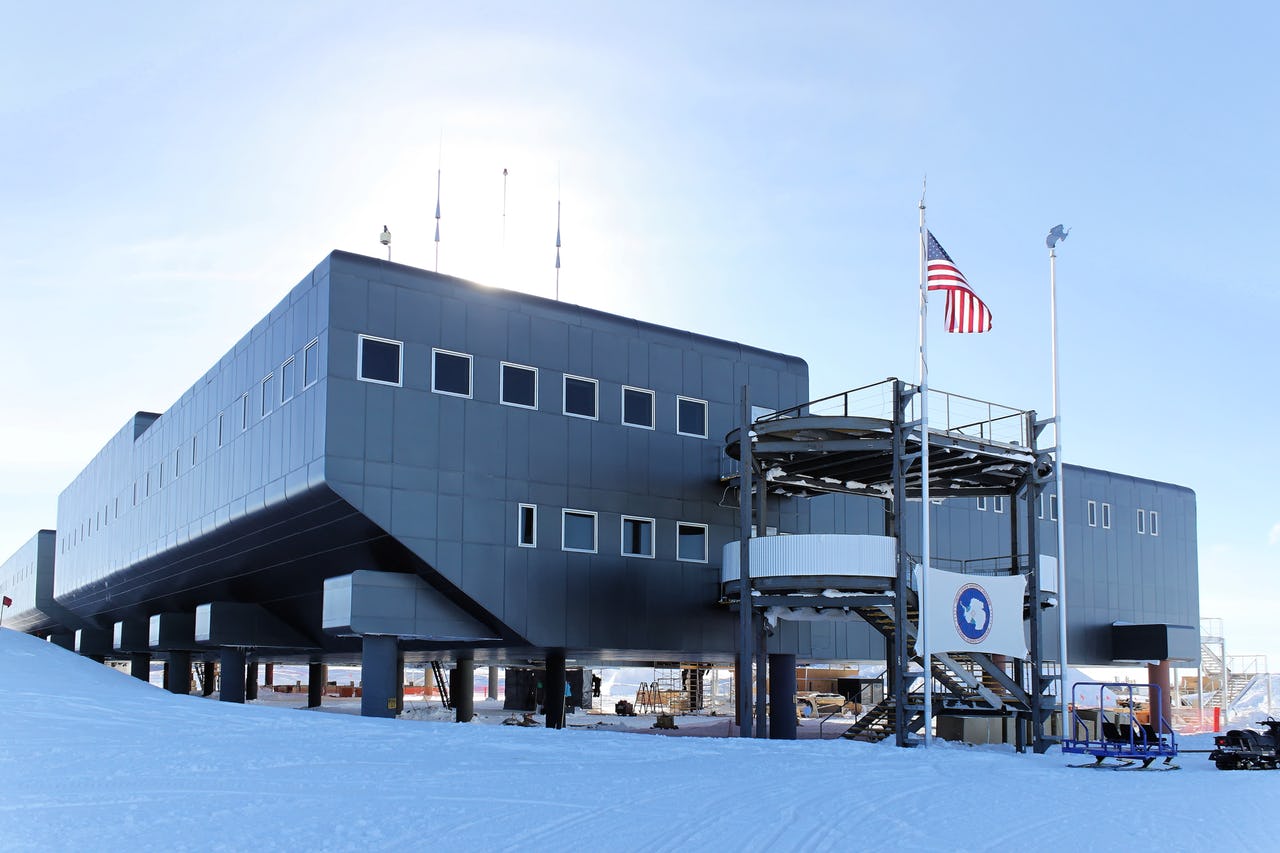Umka: A Domed City in the Russian Arctic

A view of the current Amundsen-Scott South Pole Station from 2009. This is facing Destination Alpha, one of two main entrances to the station. Photo: Daniel Leussler
Plans for the construction of an enclosed ultra-modern city on the New Siberian Island group are taking shape. The Arctic city of Umka, to be located a mere 1,000 miles from the North Pole, will house up to 5,000 residents, primarily soldiers, border guards, scientists, and oil and gas industry workers. The costs of the project are estimated at between $6.4 – $8 billion.
According to the architects Umka will be a “fully functioning city and research facility, complete with its own self-sufficient food production, a near-zero waste handling system.” The settlement will be modeled after a fictional Moon city or an isolated space station and will allow researchers to live in the region for longer periods of time rather than for short expeditions. The residents will be completely isolated from the harsh environment and live under a vast climate-controlled dome 1.2 kilometers long and 800 meter wide.
The now-released designs bear resemblance to the Biosphere 2 project constructed in Oracle, Arizona between 1987 and 1991. This artificial, materially-closed ecosystem was used to study the possible use of closed biospheres in e.g. space colonization. The project’s first closed mission lasted from September 26, 1991 to September 26, 1993 and suffered a number of setbacks like deteriorating crew morale due to interpersonal conflicts. The Umka project, while not designed as a closed biosphere, may experience similar problems due to its isolated location in the High North and its confined environment.
Technical challenges may also also arise. The structure’s heat loss during the frigid winter months will be significant and operating waste-handling and power-supply systems in -40 degree Celsius requires constant monitoring and maintenance. The city may not be reachable for months at a time, requiring vast amounts of stockpiles in provisions. The annual thawing and re-freezing of the Arctic soil will require advanced structural designs, similar to those employed by the Amundsen Scott South Pole Station, to accommodate substantial surface changes. The city’s heat emissions may have to be deflected upward to prevent the thawing of the ground during winter months.
The cost estimates may yet prove to be too conservative. The South Pole Station, which accommodates around 50 scientists year-round on 7,400 square meters, around 1 percent of the living space of Umka, cost more than $150 million to construct.
Despite claims of a near-zero waste handling system, the city’s carbon emissions will undoubtedly affect the fragile Arctic environment. The architects envision the use of floating nuclear reactors to supply the structure’s energy needs during the early stages. This also represents a risk to the region’s ecosystem. The construction of a city housing 5,000 people and the transportation of the required materials to the island will also result in emissions and pollution.
A permanent settlement far above the Arctic Circle may allow further exploration of Russia’s Arctic holdings and could be of strategic importance as a northern outpost. The New Siberian Islands are located south of the Lomonosov Ridge, an underwater ridge of continental crust in the Arctic Ocean which runs some 1,800 kilometers across the Arctic ocean, stretching from the New Siberian Island Group to Canada’s Ellesmere Island. The ridge attracted international attention when Russia submitted its claims to the UN Commission on the Limits of the Continental Shelf in 2001 in which it argued that the Lomonosov Ridge was an extension of the Eurasian continental shelf. Such interpretation would have allowed Russia to claim large portions of the Arctic, including the North Pole, as an extension to its Exclusive Economic Zone. The UN Commission deferred on making a decision and instead recommended additional research.
A permanent settlement may indirectly bolster claims of sovereignty in the region, in similar fashion to the creation of National Parks throughout the Arctic. According to former director of the Franz Josef Land Nature Reserve, Gennady Danilov: “The aim of creating [national parks] is not only and not so much to preserve nature as to ensure national security. If territory is uninhabited it may be put under international control. This is why all countries assign the status of a national park to all uninhabited territories. This is what happens on Alaska, Greenland and the Canadian islands. Nobody can claim a territory with this status.”
Despite the number of technical challenges, the prohibitively high construction costs may in the end represent the largest obstacle to the construction of Umka. It thus appears more likely that a scaled-down version of the domed city will one day become reality.